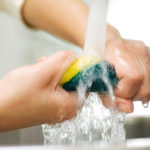Instead of soaking frozen meat in water or waiting for hours to defrost, try this quick thawing trick using vinegar and salt to prepare it instantly.
When meat is stored in the freezer, the thawing process usually takes a long time. To speed things up, many people soak the meat in warm water or use the microwave, but both methods have their drawbacks.
Soaking in water for an extended period can leach out nutrients and reduce the sweetness of the meat, resulting in a drier and less fresh piece of meat. Thawing in the microwave can lead to uneven cooking or overcooking if the timing is not precise. An effective method to quickly defrost your meat while maintaining its quality is to use vinegar and salt.
Quick Meat Defrosting Tip Using Vinegar and Salt
When taking the meat out of the freezer, apply white vinegar evenly across the surface of the meat, making sure to cover all areas. The acetic acid in the vinegar helps lower the freezing point, causing the ice crystals in the frozen meat to melt faster. Additionally, vinegar also helps eliminate any unpleasant odors from the meat.

Apply white vinegar evenly across the surface of the meat.
Next, sprinkle a layer of salt over the vinegar-coated meat. Salt helps lower the freezing point of water, accelerating the defrosting process. The combination of vinegar and salt also has antibacterial properties, ensuring that your meat is not only tasty but also safe.
Place the meat with the applied salt and vinegar on a chopping board, and you will notice moisture quickly seeping out of the meat, tenderizing it. After about 5 minutes, soak the meat in a bowl of warm water (not hot or cold) for another 5 minutes. This step not only promotes thawing but also rinses away any residual salt and vinegar without toughening or compromising the meat.
After following these steps, the meat will become easier to cut and prepare for the next cooking step, although it may not be completely tender yet.
Common Mistakes to Avoid When Defrosting Meat
Thawing During Cooking: To save time, some people add frozen meat directly to the pot and start cooking. However, this approach prolongs the cooking process and results in a loss of nutrients and flavor.
Leaving Food at Room Temperature: Some home cooks leave meat at room temperature to thaw naturally. This is a misconception as it takes too long, and the risk of bacterial contamination increases. Meat left at room temperature for an extended period is more susceptible to bacterial growth and spoilage.

Avoid leaving meat at room temperature to thaw.
Refreezing: If you defrost more meat than you need, try to cook it all instead of refreezing. Once thawed, meat is more prone to bacterial contamination. Refreezing creates an environment conducive to bacterial growth, affecting food quality and posing food safety risks when consumed later.
Overusing the Microwave: Microwaves typically have preset thawing times based on the weight of the food. Choose the correct duration to prevent overcooking, which can impact the subsequent cooking process. For microwaves without preset times, adjust the timing accordingly.
Using Hot Water: Some individuals use hot water to quickly defrost meat. This method can warm the surface while the inside remains frozen, leading to uneven meat and potential bacterial infiltration.
Meat Defrosting: A Super-Quick Guide Using Vinegar and Salt’>The Magic of Meat Defrosting: A Super-Quick Guide Using Vinegar and Salt
Introducing a revolutionary method to thaw your frozen meat in a flash! Forget the tedious wait or the conventional water bath method. It’s time to unlock the power of vinegar and salt to get your meat ready for cooking in no time. This dynamic duo will transform your culinary game, ensuring you can whip up delicious meals without the lengthy thawing process.



































